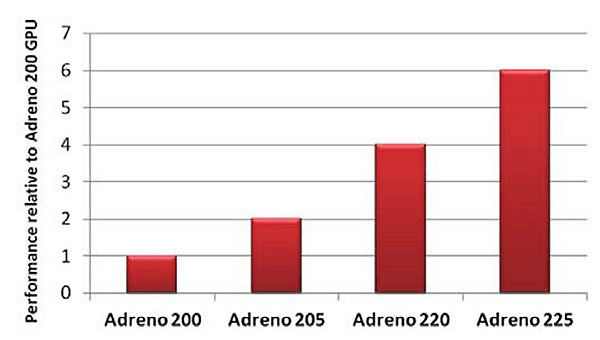Adreno graphics core
Early in 2009, Qualcomm acquired AMD's mobile graphics department, renamed its Imageon graphics core to Adreno (an anagram of Radeon, by the way) and continued the development. The first widespread Snapdragon S4 SoC uses the Adreno 225 graphics core, but the newer systems on chip are powered with Adreno 300. As yet, Qualcomm doesn't disclose much information about Adreno, but we know that Adreno has the tile architecture similar to that used by Imagination Technologies.
In the tile architecture the rendering is made in sequence, tile by tile. It gives odds when working with low-bandwidth memory. It has certain disadvantages in geometrically complicated stages, but now the use of tile architecture in mobiles is quite justified.
Both Adreno 225 and 220 are DirectX 9 class GPUs. Vertex, pixel, and other tasks are carried out by all-purpose execution devices. It increases the overall GPU effectiveness, because there are no inactive units under any type of heavy load.
Both GPUs are rather powerful. They include 8 vector blocks (each of them can execute 4 MAD commands like Imagination Tech's PowerVR SGX 543 does), and 8 scalar units. However, PowerVR SGX 543MP2 is faster, because its compiler is more efficient, its GPU has twice as many texture units, and its memory has better bandwidth. Now let's take a closer look at Adreno 225 GPU.
Adreno 225 operates at 400 MHz while Adreno 220 works only at 266 MHz. The compiling efficiency in drivers has improved as well. Finally, Adreno 225 has better capabilities for DirectX 9.3 in Windows 8: optimized shader handling, sRGB-supporting texture modules, modified rasterizer with MRT (multiple render targets) support, instancing support, and so on. As a result, the performance is 50% better:
Adreno 220 is used in SoCs with single-channel memory. It supports OpenGL ES 2.0 and Direct3D 9.0c. In turn, Adreno 225 supports Direct3D 9.3 and OpenGL ES 2.0 and dual-channel memory. According to Qualcomm, Adreno 225 based MSM8960 is faster than Apple A5. Not bad indeed.
The newer, third-generation Qualcomm's GPU are based on a new programmable architecture and yet support OpenGL ES 3.0 Halti, Direct3D 9.3, Open CL 1.2, HTML5 acceleration, 3D games, and 3D interfaces. Compared to Adreno 225, Adreno 3xx GPUs are four times faster. Speaking about Adreno 3xx, we also should give special consideration to DirectX support. Qualcomm claims the new Adreno cores are DirectX 11 compatible. It's true but only concerning the feature level 9_3, not 11_0 or 11_1. Nevertheless, NVIDIA Tegra 3 supports only feature level 9_1, which doesn't provide Direct2D hardware acceleration. Therefore, Windows RT interface can't run on Tegra 3 in a perfect way.
On the whole, Adreno 305 and 320 are among the fastest GPUs, yielding only to the latest Apple graphics today.
Communication features
Since the 28-mm MSM8960 SoC, Qualcomm products have native LTE support. Besides, MSM8960 is the first solution to support 4G LTE, WCDMA, GSM, CDMA2000, UMTS, and CDMA at once. It really helps in reducing size and power consumption of mobile devices.
Each Snapdragon S4 SoC features an integrated modem, supporting GSM/GPRS/EDGE, TD-SCDMA, EV-DO Rev. B, 3G (DC-HSPA+ Cat 24), and LTE FDD/TDD (Cat3) with simultaneous transmission of voice (via UMTS/GSM) and data (via LTE). Also, all modern Qualcomm SoCs support GPS, Bluetooth 4.0, Wi-Fi a/b/g/n, and NFC. On the whole, it seems like Snapdragon S4 offers the broadest support of communication standards on the market.
Programmable Hexagon DSP
Along with CPU and GPU cores, the modern SoCs feature digital signal processors. They provide high performance for processing audio, pictures, and similar data while consuming less power than a CPU would. Qualcomm has developed its own Hexagon DSP, which is included in Snapdragon chips.
Qualcomm's Hexagon features multithreading support, a memory manager, L1 and L2 caches. Like a CPU, the DSP unit can run several applications at the same time but is actually designed for parallel processing of audio and video data arrays. As a result, Hexagon DSP boosts performance in multimedia encoding/decoding and saves battery.
Final Thoughts
With its Snapdragon S4 Qualcomm has offered one of the best SoC family in the market, meeting all the modern requirements in terms of performance and functionality, and energy efficiency. The new 28-nm systems on chip have such excellent features as asymmetric multiprocessing, the native support of LTE and all the modern standards in communication and graphics. With improved integration capabilities the promising Qualcomm Snapdragon S4 family has certainly become a major competitor on the rapidly developing SoC market.
Write a comment below. No registration needed!




